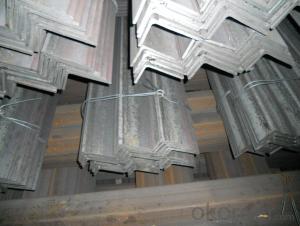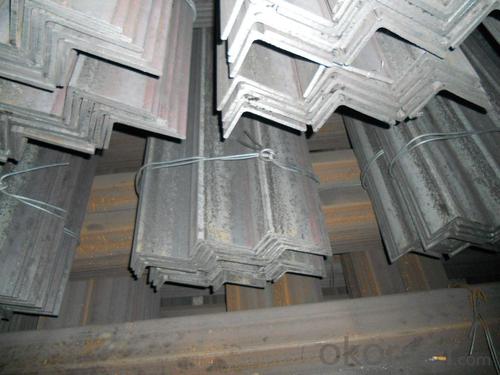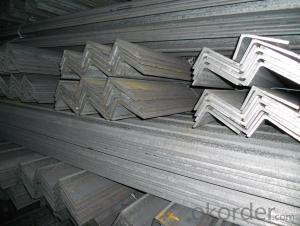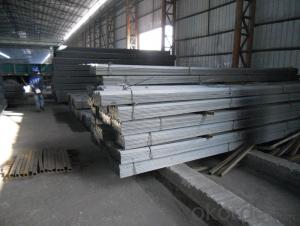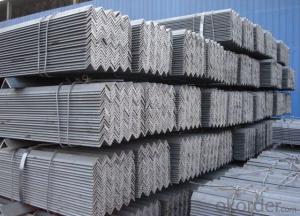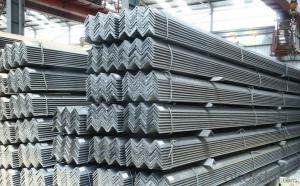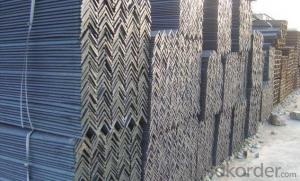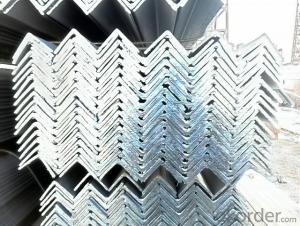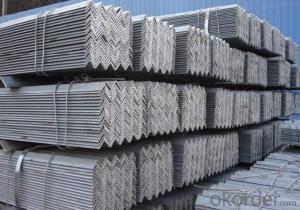Steel Unequal Angle with Good Quality 75mm*50mm
- Loading Port:
- Tianjin
- Payment Terms:
- TT OR LC
- Min Order Qty:
- 100 m.t.
- Supply Capability:
- 15000 m.t./month
OKorder Service Pledge
OKorder Financial Service
You Might Also Like
Specification
Specifications of Steel Unequal Angle with Good Quality 75mm*50mm
1. Invoicing on theoretical weight or actual weight as customer request
2. Length: 6m and 12m
3. Sizes:
| Size(mm) | Mass(kg/m) | Size(mm) | Mass(kg/m) |
| 75*50*5 | 4.8 | 75*50*8 | 7.43 |
| 75*50*6 | 5.66 |
Packaging & Delivery of Steel Unequal Angle with Good Quality 75mm*50mm:
1. Packing: it is nude packed in bundles by steel wire rod
2. Bundle weight: not more than 3.5MT for bulk vessel; less than 3 MT for container load
3. Marks:
-Color marking: There will be color marking on both end of the bundle for the cargo delivered by bulk vessel. That makes it easily to distinguish at the destination port.
-Tag mark: there will be tag mark tied up on the bundles. The information usually including supplier logo and name, product name, made in China, shipping marks and other information request by the customer.
If loading by container the marking is not needed, but we will prepare it as customer request.
FAQ:
Q1: Why buy Materials & Equipment from OKorder.com?
A1: All products offered byOKorder.com are carefully selected from China's most reliable manufacturing enterprises. Through its ISO certifications, OKorder.com adheres to the highest standards and a commitment to supply chain safety and customer satisfaction.
Q2: How do we guarantee the quality of our products?
A2: We have established an advanced quality management system which conducts strict quality tests at every step, from raw materials to the final product. At the same time, we provide extensive follow-up service assurances as required.
Q3: How soon can we receive the product after purchase?
A3: Within three days of placing an order, we will begin production. The specific shipping date is dependent upon international and government factors, but is typically 1 to 2 months.
Q4: How many tons per bundle?
A4: Around 2-3tons
Q5: How many tons can be loaded into one 20ft container?
A5: Around 23—25tons(6m)
Q6: How many tons can be loaded into one 40ft container?
A6: Around 23—25tons(12m)
Q7: How to avoid the rust after deliver the goods to the loading port?
A7: We will keep the goods at the port covered with water-proof material
Production flow of Steel Unequal Angle with Good Quality 75mm*50mm:
Material prepare (billet) —heat up—rough rolling—precision rolling—cooling—packing—storage and transportation
Images of Steel Unequal Angle with Good Quality 75mm*50mm:
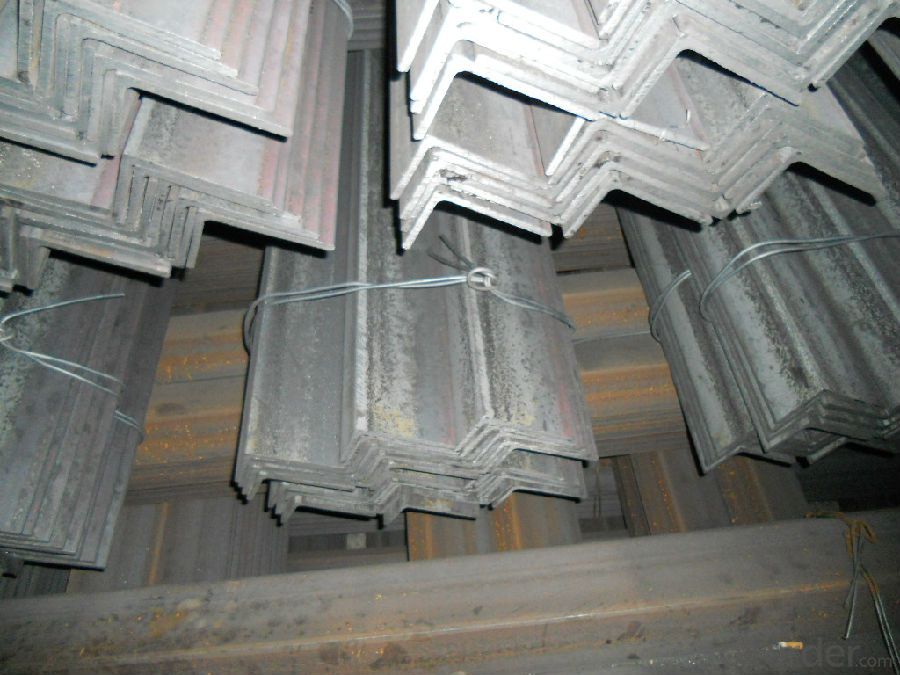
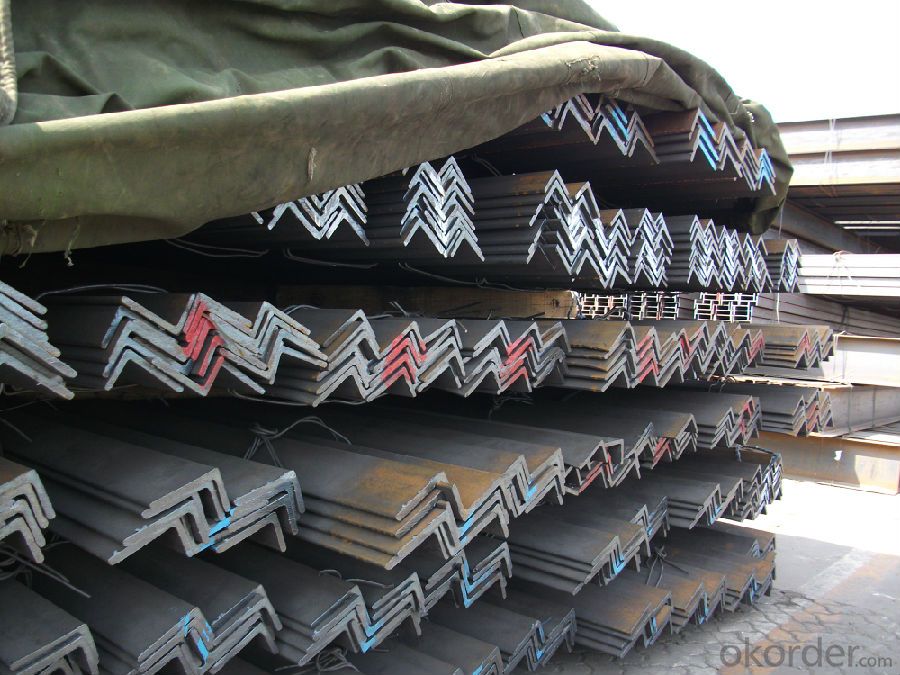
- Q: Can steel angles be used in seismic-resistant structures?
- Yes, steel angles can be used in seismic-resistant structures. Steel angles are commonly used as structural elements in buildings and bridges due to their high strength and versatility. In seismic-resistant structures, steel angles can be utilized in various ways to enhance the overall structural integrity and resistance to earthquakes. Steel angles can be used as bracing elements in seismic-resistant structures. By connecting steel angles diagonally between different structural components, they can help to distribute and dissipate seismic forces, reducing the overall impact on the structure. This helps to prevent excessive deformation or collapse during an earthquake. Additionally, steel angles can be used to reinforce and strengthen key components of the structure. For example, they can be welded or bolted to the beams and columns to provide additional support and stiffness. This reinforcement helps to withstand the lateral forces generated by earthquakes, improving the overall seismic performance of the structure. Moreover, steel angles can be employed in the construction of moment-resisting frames, which are widely used in seismic-resistant structures. In these frames, steel angles are used as the main components to create rigid connections between beams and columns, allowing them to transfer and distribute seismic forces effectively. This design strategy helps to minimize structural damage and provides better resistance to earthquakes. It is important to note that the use of steel angles in seismic-resistant structures should comply with relevant building codes and regulations. The specific design and detailing requirements may vary depending on the seismic zone and the magnitude of potential earthquakes. Therefore, it is crucial to consult with structural engineers and adhere to the appropriate guidelines to ensure the safe and effective use of steel angles in seismic-resistant structures.
- Q: How do you connect two steel angles together?
- One common method to connect two steel angles together is through welding. Welding is the process of melting the edges of the angles and fusing them together using an electric arc or flame. This creates a strong and permanent connection between the two angles. Prior to welding, it is important to prepare the surfaces by cleaning them from any contaminants or rust. Additionally, aligning the angles properly and securing them in place with clamps or tack welds helps to ensure a precise and accurate connection. Another option to connect steel angles is through the use of bolts or screws. This method involves drilling holes through the angles and then using nuts and bolts or screws to fasten them together. It is crucial to select appropriate fasteners and ensure they are tightened securely to achieve a strong connection.
- Q: What are the different types of steel angles used in fencing and gates?
- Fencing and gates commonly utilize several types of steel angles. An example is the equal angle, also known as the L-shaped angle, which has sides of equal length. It is frequently employed for vertical and horizontal bracing in fencing and gates. Another variant is the unequal angle, which features one longer side and one shorter side. This type is often used for diagonal bracing, providing added strength and stability to fencing and gates. The rounded edge angle is another option, replacing sharp corners with rounded edges. This choice is favored in fencing and gates to minimize the risk of injury, as the rounded edges are less likely to cause cuts or other accidents. Additionally, there are slotted angles that come with pre-drilled holes along their length. These holes facilitate the easy attachment of fencing and gate components such as panels or hinges. Finally, galvanized angles are coated with a layer of zinc to safeguard against rust and corrosion. This type is particularly suitable for outdoor fencing and gates, offering long-lasting durability and resistance to the elements. In conclusion, the various types of steel angles used in fencing and gates provide different advantages in terms of strength, stability, safety, ease of installation, and resistance to rust and corrosion. The choice of angle will depend on the specific requirements and preferences of each fencing or gate project.
- Q: What is the maximum allowable compressive stress for a steel angle?
- The maximum allowable compressive stress for a steel angle depends on various factors such as the type of steel, its dimensions, and the specific design and safety codes being followed. It is recommended to refer to the relevant structural engineering guidelines, codes, or specifications to determine the exact maximum allowable compressive stress for a steel angle in a particular application.
- Q: How do you calculate the axial load capacity of a steel angle?
- To calculate the axial load capacity of a steel angle, you need to consider several factors including the material properties of the angle, its dimensions, the type of loading, and the safety factor. First, you should determine the yield strength of the steel angle. This value represents the maximum stress the angle can withstand without permanent deformation. The yield strength can be obtained from the steel angle's specifications or by conducting material testing. Next, you need to measure the dimensions of the angle, including its length, thickness, and width. These values are crucial in determining the area of the cross-section of the angle. Once you have the yield strength and the cross-sectional area, you can calculate the axial load capacity using the formula: Axial load capacity = Yield strength × Cross-sectional area It is important to note that this formula assumes that the angle is subjected to direct axial loading. If the angle is subjected to combined loading or other complex loading conditions, additional calculations or structural analysis may be required. Moreover, it is customary to apply a safety factor to the calculated axial load capacity to account for uncertainties and ensure structural integrity. The safety factor is typically determined based on the specific application and industry standards. For example, a safety factor of 1.5 is commonly used in structural design. In summary, to calculate the axial load capacity of a steel angle, you need to know its yield strength, measure its dimensions, and apply the appropriate safety factor. This calculation provides an estimate of the maximum load the angle can bear without failure under axial loading conditions.
- Q: Can steel angles be bolted together?
- Indeed, it is possible to bolt steel angles together. Steel angles find frequent application in construction and fabrication endeavors, and bolting emerges as a prevalent technique for their connection. By bolting steel angles together, a robust and reliable linkage is achieved, capable of enduring substantial loads and forces. Typically, the angles are drilled with holes at designated intervals, through which bolts are inserted and secured with nuts, thereby fastening the angles together. This approach facilitates effortless disassembly and reassembly when necessary, rendering it a versatile and pragmatic option for joining steel angles.
- Q: Can steel angles support heavy loads?
- Steel angles have the ability to bear heavy loads. These L-shaped metal bars, known as steel angles, are frequently employed in construction and engineering for their sturdy and long-lasting nature. The unique design of steel angles enables them to evenly distribute weight, rendering them capable of enduring substantial loads. They are commonly utilized as structural supports and reinforcement in a variety of structures, including buildings, bridges, and machinery. Furthermore, engineers can tailor the dimensions and thickness of steel angles to meet precise load demands, making them a dependable option for supporting heavy loads.
- Q: How do you determine the required number of fasteners for a steel angle connection?
- To determine the required number of fasteners for a steel angle connection, several factors need to be considered. These include the load being applied, the size and thickness of the angle, the type and strength of the fasteners being used, and any applicable building codes or engineering standards. Typically, calculations or guidelines provided by structural engineers or industry standards are used to determine the minimum number and spacing of fasteners needed to ensure the connection is strong and safe.
- Q: What are the different types of steel angles used in storage racks?
- Storage racks commonly utilize various types of steel angles to ensure strength and stability, facilitating efficient storage and organization of items. 1) The most frequently employed steel angle in storage racks is the equal angle. It possesses identical sides and serves as the primary support beam in the rack's structure. The balanced weight distribution and stability it offers make it ideal for this purpose. 2) Unequal angles, as the name implies, have varying side lengths. These angles find application in storage racks that necessitate specific weight distribution or load-bearing requirements. The longer side of the unequal angle provides additional support for heavier items or different storage configurations. 3) Slotted angles are versatile, allowing convenient adjustment and customization of storage rack systems. They feature slots along their length, enabling the addition of shelves, dividers, or other accessories as required. Slotted angles are commonly found in warehouses or industrial settings where frequent reconfiguration of the rack system is necessary. 4) Perforated angles contain holes punctured along their length, offering improved ventilation and visibility for stored items. They are often employed in storage racks for items that require airflow or in retail settings where product visibility holds significance. 5) Corner angles, on the other hand, are L-shaped steel angles used to reinforce and strengthen the corners of storage racks. They provide additional support and stability, preventing the rack from collapsing or tipping over when heavy items are stored on the shelves. Ultimately, the choice of steel angle for storage racks relies on specific requirements such as load-bearing capacity, customization options, ventilation needs, and visual appeal. By selecting the appropriate steel angle, storage racks can be optimized for maximum efficiency and durability.
- Q: What are the common welding techniques used for steel angles?
- The common welding techniques used for steel angles include shielded metal arc welding (SMAW), gas metal arc welding (GMAW), and flux-cored arc welding (FCAW).
Send your message to us
Steel Unequal Angle with Good Quality 75mm*50mm
- Loading Port:
- Tianjin
- Payment Terms:
- TT OR LC
- Min Order Qty:
- 100 m.t.
- Supply Capability:
- 15000 m.t./month
OKorder Service Pledge
OKorder Financial Service
Similar products
Hot products
Hot Searches
Related keywords
